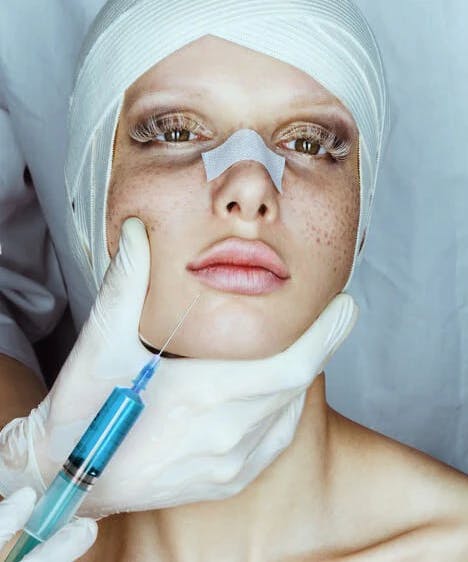Facial Feminization Surgery Isn’t Life-Saving, It Just Reinforces The So-Called “Toxic Gender Binary”
Congrats on the new face, Dylan Mulvaney. You’ve really done a great job putting womanhood in a box.

Recently, the infamous creator of the TikTok series “Days of Girlhood,” Dylan Mulvaney, posted a “face reveal” after recovering from facial feminization surgery (FFS). When praising the procedure, a newly-made staple in “gender-affirming care” for transgender-identifying patients, Mulvaney said, “I just hope that all trans and nonbinary people can get the gender-affirming resources that they need because this is life-changing and sometimes life-saving.”
Without a doubt, facial plastic surgery can change lives. The intention of these types of procedures is to reconstruct facial features post-injury or fix defects, after all. As time has gone on though, plastic surgery has also become a beauty tool that, in safe amounts, can genuinely boost a person’s self-confidence.
Now with the latest “gender-affirming” facial surgeries, patients undergo permanent structural changes to their faces with those in support of the surgeries labeling them as a "medical necessity." But this just simply isn’t the case. Not only does FFS fail to be an any kind of actual “life saver,” but it also reinforces that pesky little “toxic gender binary” that LGBT activists bemoan.
Let’s talk about the truth behind gender appropriation and how activists like Mulvaney are placing womanhood in a box.
What Is Facial Feminization Surgery Anyway?
In a recent interview with Yahoo Life, director of Johns Hopkins Center for Transgender Health Fan Liang, MD, asserted that facial feminization surgery is “absolutely” not a cosmetic surgery and rather is “medically necessary,” in an attempt to draw a line in the sand between cosmetic surgeries for personal preference and facial rejuvenation and those done on trans-identifying patients.
Sometimes called gender reassignment surgery or GRS, FFS and bodily procedures like breast implants are typically excluded from insurance coverage because they’re considered cosmetic. The total cost for FFS averages between $30,000 and $50,000, depending on how many tweaks are needed to get a biological male face to resemble that of a female. In Mulvaney’s case, this included a jaw shave, chin reduction, tracheal shave, minor cheek enhancement, rhinoplasty, brow bone shave, and hairline advancement.

When a biological woman is looking to slightly alter her appearance (perhaps slimming a large nose), she must pay out-of-pocket for her nonessential procedures. But trans-activists have pushed for all major insurance companies to recognize gender-affirming care on the basis that trans-identifying individuals need to undergo these surgeries to improve their mental health.
Perhaps the insurance companies aren’t so bothered by this societal shift, since transitioning has created lifetime patients and, as a result, a very deep well of profits to continually dip into. By 2026, Global Market Insights predicts that sex reassignment surgeries alone will exceed $1.5 billion in global market valuation.
How does this happen? Let's say a young individual is pushed down the pipeline to transition from one sex to the other. He or she is injected with puberty blockers (like Lupron, despite its long list of side effects) at a young age. Per month, Lupron may cost up to $2,500 without insurance, and the three-month estimated out-of-pocket cost is as high as $9,500.
It’s no wonder that Lupron has now seen a boom in domestic net revenue to the tune of $5 billion since 2013! What’s more, emails recently unearthed reveal that U.S. Assistant Secretary for Health Rachel Levine (a trans-identifying biological male) knows that the transition industry is an opportunity for revenue.

Go Under the Knife To Save Your Life
What was once an elective surgery can be newspeaked into a medical necessity with carefully pruned research from “experts.” Despite the World Health Organization dropping the classification of transgenderism as a mental illness, the argument in favor of FFS often relates back to that. If you insist that cosmetic surgeries to “reassign” your gender should be covered by insurance because they combat your gender dysphoria, I’m sorry, that psychological distress hints at mental illness. If it’s not a mental illness, then this is just a style choice and is no different from a biological woman who wants to undergo similar procedures to look more feminine.
Yet, trans-activists will lean on the dangers associated with trans-identifying individuals not receiving medical interventions. In fact, last year, the Biden Administration issued a statement to confirm “the positive effects of gender-affirming care” for both adults and children alike. Why? Because of the narrative that gender dysphoric individuals will be driven to suicide if they don’t medically transition.
The “Quality of Life Research” paper, for example, published in 2010, says that “transwomen have diminished mental health-related quality of life compared with the general female population. However, surgical treatments (e.g. FFS, GRS, or both) are associated with improved mental health-related quality of life.” But if you actually try to look into the research, you’ll find that only 247 biological male participants were enrolled in this self-reported study. And how long did the study run for? That’s a great question, because I genuinely can’t find out! That doesn’t appear to be public information — perhaps because it would discredit the findings?
This narrative is purposefully spread despite the fact that there isn’t actually strong evidence to show that gender transition reduces the likelihood of suicide.
Sadly, there’s more research to suggest the exact opposite: Puberty blockers, hormone replacement therapy, and surgical transition exacerbates the psychological distress that leads to suicidal ideation. It’s simple: Transitioning masks underlying psychological problems that produce gender dysphoria. Surgeries may treat the symptoms but not the underlying cause.
In spite of all of this, yes please, let’s provide taxpayer funding (à la Canada’s model) to increase insurance coverage for gender-affirming care even though, historically, upwards of 95% of gender dysphoric children grow out of it, and most end up identifying as gay.

Sure, facial feminization is life-altering, but it's hard to find any evidence of it being life-saving. If these individuals actually suffer from body dysmorphic disorder, based on the clinical diagnosis of the condition, they will likely never feel complete nor satisfied with their appearance no matter how many procedures they undergo. Trans-identifying patients go under the knife to try to become physically more like what they envision themselves to be on the inside, but let’s really think for a second about what this “look” is that they’re going for.
So Much for Smashing the Gender Binary
Last time I checked, LGBT activists have always been quick to dissect the gender binary. Gender exists on a spectrum, they preach (especially to students), and we need to look beyond it. As much as half of Gen Z apparently believes that the gender binary is outdated. If this is the case, that gender stereotypes are a relic of the past, then why in the world does gender-affirming care matter so much that it should be subsidized by the government or covered by insurance companies?
I'm sorry to say: You can’t have your cake and eat it too. After all, who is to say that a biological woman who identifies as her natal sex shouldn’t be allowed to affirm her gender with a boob job if she feels her A-cups aren’t feminine enough? Sorry to be doubly trite, but not only is beauty truly the eye of the beholder, we are also our own worst critics.
When it comes to the female face, there are some defining features that appear on the average woman, but not everyone has those features. In the field of biological anthropology, researchers can recognize the difference between males and females on a skeletal level. Females tend to have wider, more tilted pelvises and less pronounced brow bones, and males tend to have larger and more robust bones.
Appearance of typical female estrogen levels correlates to a rounder jawline, higher eyebrows, and fuller lips. Men are more likely to have heavier jawlines, a bony ridge on their brow, and of course the more prominent Adam’s apple. These are all features that appear on average and aren’t guaranteed just by being biologically female or male. Again, a dainty nose or a slim jawline may look feminine, but including it in facial feminization surgery would mean admitting that there are definitive female traits.

So, let’s also dispel the myth that there’s somehow a right or wrong way to look like a woman, and I’m speaking to both sides of the aisle on this one. One side romanticizes the “trad wife” who embodies all of the most feminine traits: delicate facial features, small in stature, slim but fertile. If you don’t fit that mold, you must not be a very high-value woman. The other side insists how empowering it is for a woman to go against the grain, dress masculine, and perhaps even undergo procedures that de-sex them. You’re not a woman, honey, you’re non-binary, and you certainly won’t regret tying your tubes or getting a double mastectomy in an effort to look androgynous.
Women really don’t need to conform to Mulvaney’s “woman face” to be influential, powerful, or fulfilled in any other capacity. Look back in history. Margaret Thatcher had a prominent nose. Sally Ride has thin lips. What about today’s celebrities? Cara Delevingne is practically known for her prominent brow ridge. Same goes for Nicole Kidman. Does Lucy Liu’s square jawline make her less of a woman? Obviously not.
It’s all well and good that Mulvaney can afford to make these bodily changes after amassing 10 million TikTok followers and earning an estimated $1.5 million in net worth. This comes from partnered posts with brands like EOS which have been featured in the “Days of Girlhood” series. Some sources report that Mulvaney makes up to $100,000 per month from the series alone.
Alas, most people with gender dysphoria don’t make that kind of money to have their forehead, nose, jaw, chin, brow, trachea, and hairline permanently adjusted. I’d wager that nonsurgical procedures may also be out of the question, like fat grafts, regular Botox injections, and cosmetic fillers. Their allegedly diminished mental health-related quality of life simply can’t be fixed by band-aid solutions.
Self-worth is an intrinsic value, something that even biological women have to come to terms with. A procedure that boosts a biological woman’s self-confidence can often be left at that. But, when you’re in mental health territory, there’s just no saying if a person will ever feel adequate when a clinically diagnosable mental condition is to blame.
Closing Thoughts
There are a lot of extreme costs associated with chasing an ideal. One or two cosmetic procedures here or there likely won’t break the bank, but undergoing dramatic, permanent facial transformations is not just something that should be toyed with to achieve your “woman face.”
If you’re a biological woman, you have a woman’s face, regardless of what it looks like. If you’re a biological male who dreams of being a woman, you can go under the knife to attempt to become your ideal self, but will it work? Will it ever be enough?
Don’t miss anything! Sign up for our weekly newsletter and get curated content weekly!